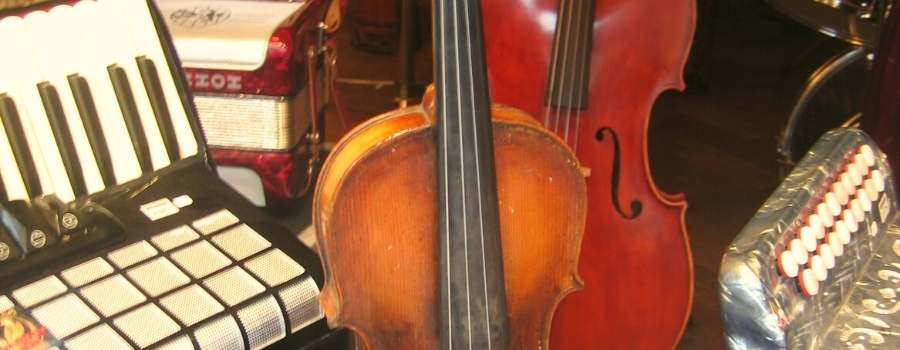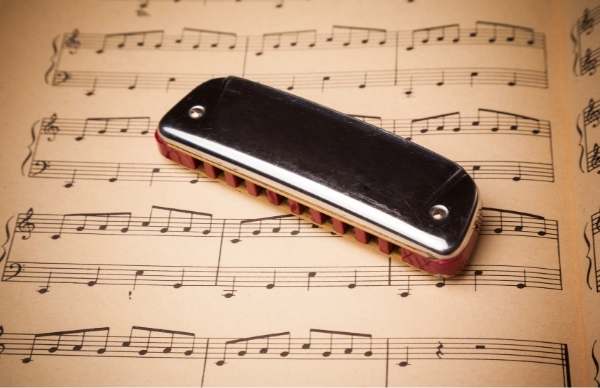
Despite the thousands of different instruments around the world, most can be classified into a particular family. Violins fall cleanly into the stringed family, while clarinets and flutes sit comfortably with other woodwinds. Trumpets and tubas make up the brass family, while marimbas and timpani are obviously percussion instruments.
But some instruments bridge several categories or could be squeezed into more than one category. Most of us learn that there are four main families of instruments, strings, brass winds, woodwinds, and percussion…but where is an accordion going to go? It has a piano-style keyboard and pianos are technically percussion instruments, but it also has bellows that push air through the instrument…so is it a woodwind?
As you get more into the study of music you learn that there is actually a much more diverse category system for musical instruments called the Hornbostel-Sachs classification. This system helps give a much more accurate family description to accordions.
What Family Of Instruments Does An Accordion Belong?
Accordions fall into a family of instruments called the free-reed aerophone family. This category includes other instruments such as the concertina, bandoneon, and harmonica. It stands apart from other instrument families for its box-shaped design, bellows, and internal reed components.
Free-reed aerophone seems like a complicated term, but when defined gives a much better description of what an accordion actually is…how it produces its sound.
What Is A Free-Reed Aerophone?
A free-reed aerophone is a musical instrument with a vibrating reed in a frame that creates sound when air passes by. Breaths or bellows are used to create air pressure. The frame also has a keyboard, which is used to direct the airflow over different reeds.
When you press down on the keys of an accordion, it forces air through the reeds and produces sound. The pitch of the sound produced depends on the size and shape of the reed. Larger reeds will produce lower notes, while smaller reeds will produce higher notes.
Are Accordions Wind Instruments?
Accordions are not considered wind instruments even though they do use air to produce sound. What makes them different from woodwinds is that they use bellows to push air over a reed system inside of the instrument.
It’s easy to think that accordions are wind instruments. After all, they have bellows, and when you push or pull on the bellows, the air goes into or out of the instrument, right? This is complicated even further when you consider that they have internal reeds that produce sound. Yet, accordions are not actually wind instruments.
While an accordion does have internal reeds, the main difference is that you must blow into the reads or pipes to make a woodwind work. With an accordion, though, you simply pump the bellows to bring air into the instrument. Because you don’t blow into an accordion, it simply can’t be classed as a woodwind.
Are Accordions Aerophones?
In general, accordions are considered aerophones but they are specifically in a sub-category called free-reed aerophones since they use bellows to push air over a set of internal, free-reeds.
Aerophones make up a huge swath of all musical instruments. After all, an aerophone is any musical instrument that produces sound when air is blown through it. This includes woodwinds and brass instruments. What sets accordions apart, though, is their use of free reeds.
Free-reed aerophone instruments are a class of instruments that produce sound when a column of air is forced through large, internal metal reeds. This family of instruments includes the harmonica, the accordion, and the concertina. Unlike brass or even woodwind instruments, free-reed aerophones use slim metal reeds rather than wooden reeds.
This produces a unique sound that falls somewhere between a violin and an organ. It has a very bright and cheerful tone that can sometimes even reach shrill, metallic pitches and can be heard from a considerable distance.
The pitch of the sound produced by an accordion depends on the size and shape of the reed. Larger reeds produce lower notes, while smaller reeds produce higher notes. The pitch can also be affected by the speed of the air passing through the reed. By pressing down on different keys, you can change the pitch of the notes being played.

What Instruments Are Considered Free-Reed Aerophones?
Accordions, harmonica, and concertinas are probably the most well-known free-reed aerophones, especially in western culture. But other free-reed aerophones do exist such as the bandoneon and the sheng.
Out of all of the free-reed aerophone instruments, the accordion is perhaps the most unique. By combining a set of bellows with a keyboard and internal metal reeds, it smoothly rides the line between the brass, woodwind, and keyboard families while somehow managing to be its own unique thing. This is what makes the accordion so special.
Here is a short list of free-reed aerophones categorized by locations they are most popular or known.
Americas and Europe
- Accordion
- Harmonica
- Bandoneon
- Melodica
- Pump Organ
- Concertina
Asia
- Sheng
- Sho
- Khee
These are the most popular instruments…based on location, of course…in the free-reed aerophone family, but there are also variations on these instruments (different keys, builds, etc) so this list is definitely not comprehensive.
Final Thoughts
When compared to other instruments, it’s not always easy to classify the accordion. Is it a percussion, keyboard, or woodwind instrument? Although it has qualities of each category, it actually falls into its own classification—free-reed aerophones. Along with the harmonica and concertina, the accordion stands out from the crowd with its unique sound and powerful combination of other musical components.
